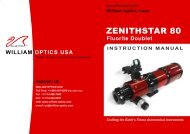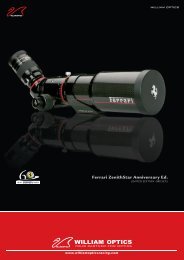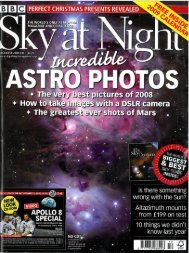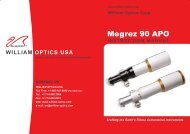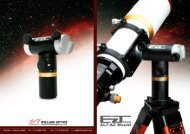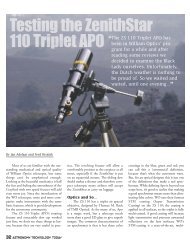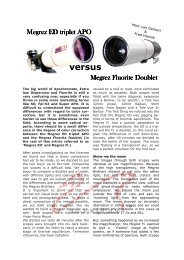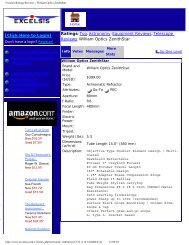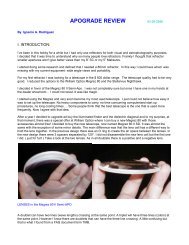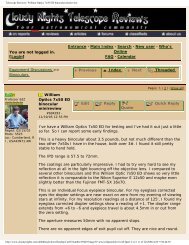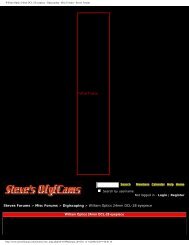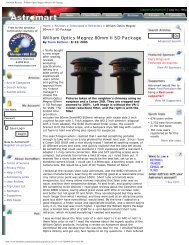CN Report: The UWAN Eyepieces - William Optics
CN Report: The UWAN Eyepieces - William Optics
CN Report: The UWAN Eyepieces - William Optics
- No tags were found...
Create successful ePaper yourself
Turn your PDF publications into a flip-book with our unique Google optimized e-Paper software.
<strong>CN</strong> <strong>Report</strong>: <strong>The</strong> <strong>UWAN</strong> <strong>Eyepieces</strong>Search CloudyNightsAdvancedHome / <strong>CN</strong> <strong>Report</strong>: <strong>The</strong> <strong>UWAN</strong> <strong>Eyepieces</strong>by Tom Trusock 04/09/06 | Email AuthorDownload this DocumentVoice your opinion about this topic in the forumsSearchWednesday, April26, 2006Cloudy NightsSupportersAstronomicswww.astronomics.comHas Al Nagler finally got some competition?28, 16, 7, and 4mm <strong>UWAN</strong> <strong>Eyepieces</strong> - <strong>William</strong> <strong>Optics</strong>Tom Trusock 4/06Those of you who•e been reading my reviews for a while know that I• an eyepiece junkie ?I• always looking forthat perfect eyepiece. Well, the Tele Vue eyepieces come as close to anything I•e ever found, but they have onerather apparent drawback ?they aren• cheap. If you•e ever seen the blem line at NEAF, you•l begin to appreciatewhat amateurs will do in order to save a few bucks off a Nagler (or three).Ironically, in my opinion, it was the introduction of the Tele Vue Naglers that helped to spark the dobsonianrevolution ?those gorgeous well correct wide fields finally enabled amateurs to own a large, fast telescope withoutmany of the optical aberrations inherent in the system. Tele Vue• motto has been •he eyepiece is ?thetelescope.? In fact, for some of us ?those with multiple scopes ?they are the more important half. I may only usecertain telescopes a few nights a year ?but the eyepieces? <strong>The</strong>y get used every time I go out.Anttlers <strong>Optics</strong>Astro Custom CasesATS PiersAgena AstroAPM TelescopesAstronomy ShoppeAstronomyTechnologiesBackyardObservatoriesBarry Crist MiniaturesBigBinoculars.comBigha<strong>The</strong> Bino ObservingChairBurgess OpticalCape InstrumentsCats Eye CollimationCelestronChristophers, ltd.ClearVue <strong>Optics</strong>CoronadoDBA AstronomyProductsDenkmeier OpticalDGM <strong>Optics</strong>Digitec OpticalDiscMounts IncDreamscopesEyelightFaint FuzziesJ&T TelescopeFirst TelescopeGarret OpticalHelix ObservingAccessoriesHouse of <strong>Optics</strong>GermanyHowtopickatelescope.comInfinity Scopes, LLCInspiration ToolworksKen's Rings & ThingsLXD55.comMag 1 InstrumentsMeadeMercury SystemsSupporthttp://www.cloudynights.com/item.php?item_id=1433 (1 of 9)2006/4/26 •• 04:16:09
<strong>CN</strong> <strong>Report</strong>: <strong>The</strong> <strong>UWAN</strong> <strong>Eyepieces</strong>It• all about the spacewalk experience ?Al defined that with the Nagler t1•. Amateurs had never seen anything likethem before ? an eyepiece so immersive it was like you were falling out a window. For the first time, it felt like youwere part of the scene ?not simply observing it from afar. I remember my first look through a Nagler ?it definitelyhad an impact on my pocket book.It• no small wonder that amateurs tend to snap them up in droves.28mm <strong>UWAN</strong>Weight - 2lbs 3.2 oz (w/ caps)Field Stop ~43mm measured (43.5 stated)Eye lens diameter ~27mmAFOV 82 deg (stated)6 Elements in 4 groups18mm eye relief (stated)Barrel Size 2?br> Price $3987mm <strong>UWAN</strong>16mm <strong>UWAN</strong>Weight - 9 ozField Stop ~25mm measured (28.6mm stated)Eye Lens Diameter ~21mmAFOV 82 Deg (stated)7 elements in 4 groups12mm Eye Relief (stated)Barrel Size 1.25?br> Price $2384mm <strong>UWAN</strong>Weight - 8.2 ozWeight - 8 ozField Stop ~14mm measured (25.8mm stated) Field Stop ~7mm (24.5mm stated)Eye Lens Diameter ~20mmEye Lens Diameter ~16mmAFOV 82 Deg (stated)AFOV 82 Deg (stated)7 elements in 4 groups7 elements in 4 groups12mm Eye Relief (stated)12mm Eye Relief (stated)Barrel Size 1.25?br> Price $198Barrel Size 1.25?br> Price $198Since that first Nagler, different ultra wides have come and gone as many manufacturers have tried to capitalizeon the new market in immersive eyepieces.Before I get pounced on by the Pentax lovers for proclaiming Al• progeny •ing of the Hill? let me define the classof eyepieces I• looking at. In my opinion, there are two distinct classes of wide field eyepieces ?those in the 65-70deg AFOV camp, and those in the 80 deg plus arena. <strong>The</strong> 65-70• are super wides, while the 80 plus• we•l put inthe ultra wide camp. Thus Pentax had their XL• (65 AFOV) and currently offers their XW• (70 AFOV). <strong>The</strong>re is nodoubt these are excellent eyepieces, but by my admittedly somewhat arbitrary definition, their AFOV puts them inthe super wide class ?a step below the Naglers in apparent field size, so for this article ?I• not considering themas competitors to the Naglers.Optical MechanicsParticle WaveTechnologiesPier-TechScopeGuard CasesScope'n'SkiesScopes4rentScopeStuffShoestringAstronomySoftware BisqueStarbucketsStarmasterStellar OpticalStellarvueSun River NatureCenterTelescope SolutionsTele VueTeeter's TelescopesTelescopeWarehouseThink AstronomyTeleTradeTMB OpticalTscopesUltra DarklightUniversity <strong>Optics</strong>Walt's ObservingChairs<strong>William</strong> <strong>Optics</strong>Woden <strong>Optics</strong>So let• take a quick look at the ultrawide arena.<strong>The</strong>re have been some real exotics on the market. <strong>The</strong> Leitz 30mm (88 deg afov) is one example. You think $600for a Nagler 31 is high? I•e seen samples of the Leitz go for over $1500.<strong>The</strong>n we have the Japanese Widescan III•, the Speers Walers, not to mention the Meade 4 and 5k•.And of course there have been the cheaper knock offs. Everyone wants that spacewalk experience, but noteveryone can pay $300 or more for an eyepiece. In recent years, we•e seen a deluge of Widescan II clones hitthe market. <strong>The</strong>se tend to perform acceptably well at longer focal lengths, but simply can• touch the Naglers infaster telescopes where the design has problems dealing with steep light cones. And in terms of fit and finish?Well...No, in my opinion, the only real competition Tele Vue has had in the ultra wide field department has come fromMeade, with their series 4000 UWAs. <strong>The</strong> 14 and 8.8mm in particular were quite possibly the two best eyepiecesto ever come out of Irvine, CA. Meade achieved parity until the introduction of the t5s and t6s. <strong>The</strong>y had a realshot at Tele Vue again when they released the 5k UWAs last year, but lack of attention to a few minor (yet crucial)details took them out of the running ?at least in certain focal lengths.Now there is additional competition starting up the hill. TMB has a new series coming out ?the Paragons. <strong>The</strong>ywill be headed to market a little later this year, and are coming in a couple of different flavors. A super wide that•in the Pentax/Panoptic field of view class, and an ultra wide that• in the Nagler class. <strong>The</strong> 40mm Paragon inparticular sounds very interesting. I've heard details concerning the spot size both on axis, and at the edge offield. If that plays out in the real world like they think it will - they are going to have a heck of an eyepiece. But theyaren• the only ones on the horizon ?in fact, one competitor is already here.http://www.cloudynights.com/item.php?item_id=1433 (2 of 9)2006/4/26 •• 04:16:09
<strong>CN</strong> <strong>Report</strong>: <strong>The</strong> <strong>UWAN</strong> <strong>Eyepieces</strong>Top Row Left to Right: <strong>UWAN</strong> 4, <strong>UWAN</strong> 7, <strong>UWAN</strong> 16, <strong>UWAN</strong> 28Bottom Row Left to Right: Burgess / TMB 4mm, Nagler 7mm t6,Nagler 16mm t5, Nagler 26mm t5 (w/ Dioptrx)<strong>William</strong> <strong>Optics</strong> has a small line of ultra wide eyepieces that has been out for a few months, and are slowlygathering steam in the amateur community. Named the <strong>UWAN</strong>s (Ultra Wide ANgle), their prices are about 2/3that of the comparable focal length Naglers. <strong>The</strong>ir line currently offers 4 focal lengths, and is somewhat tailored totheir refractors in that regard. <strong>The</strong> biggest and most expensive in their line up would have to be their 28mm<strong>UWAN</strong> - <strong>The</strong> Beast. This monster tops the scales at over 2lbs and just dwarfs the others in the series, the 16mm,7mm and 4mm. WO• been around for about 10 years now, and they have lately been concentrating in making adent in the mid-level refractor market. <strong>The</strong>y have branched off into a number of accessories ?but their only otherline of eyepieces are the SWANs (SuperWide ANgle). While they represent a decent value for the price, theyaren• in the same league as the Panoptics or the Pentaxes. Thus I suspect most amateurs probably weren•initially expecting much more out of the <strong>UWAN</strong>s. I know I wasn•.That is, until I had a chance to look through one.<strong>William</strong> <strong>Optics</strong> showed the 28mm prototype at NEAF last year, and while NEAF isn• exactly conducive to testingnew gear (at least night time gear), I did get a chance to look through it in the daylight, and bluntly ?I wasimpressed. So when I was contacted and asked if I• be interested in doing a review of the line, I jumped at thechance. I was quite anxious to find out how these compared to my long time favorites, those undisputed kings ofthe wide field hill, the Tele Vue Naglers.Test Equipment<strong>William</strong> <strong>Optics</strong> shipped the complete set to me in late December and since then I•e had a chance to test them in avariety of telescopes. I•l tell you up front they told me they designed them with their refractors in mind, and theyhadn• actually tested them in fast dobs ?so I guess neither one of us really knew what to expect. But I• getting abit ahead of myself here.About the same time the <strong>UWAN</strong>s showed up (or prior to that), they also shipped me a ZS105 triplet apo, a 66 SDand 66 ED triplet ?all for review / evaluation, so I was able to test the <strong>UWAN</strong>• in those in addition to my owntelescopes. I also own a couple other scopes (66mm doublet, 80mm FD, 102mm TV102, 102mm FS102NSV) andhad a few telescopes in for review during this time frame - a 10?DBA Certified, and the new Meade 12 inchLightBridge from Astronomics. If you're keeping track, this means they were tested at f5, f5.9, f7, f8 and f8.6 - forstarters. But there was one scope in particular, one that I was most interested in getting them in, my 18?Obsession. At f4.5, this was the biggest torture test I could throw at the line. How• they fare? We•l get there?br>http://www.cloudynights.com/item.php?item_id=1433 (3 of 9)2006/4/26 •• 04:16:09
<strong>CN</strong> <strong>Report</strong>: <strong>The</strong> <strong>UWAN</strong> <strong>Eyepieces</strong>Field lens - Left to Right - 4mm <strong>UWAN</strong>, 7mm <strong>UWAN</strong>, 16mm <strong>UWAN</strong>, 28mm <strong>UWAN</strong>Since the Naglers are the de facto kings of the ultrawides, it seemed only right to gauge the <strong>UWAN</strong>s performanceby the equivalent focal length Tele Vue ?or as close as I could get. I tested the 28mm <strong>UWAN</strong> against the 26mmNagler t5, the 16mm <strong>UWAN</strong> against the 16mm t5, the 7mm <strong>UWAN</strong> against the 7mmt6, but for the 4mm ?I was leftin a quandary as there is no exact Nagler match. Even a minor difference in focal lengths can have a large effect ?higher magnifications make the background darker and thus increase apparent contrast (another reason thatamateurs love Naglers ?they give you the same field of view as a lower powered eyepiece, but the advantages ofa smaller exit pupil and higher magnifications). Obviously, these effects are more pronounced with shorter focallength eyepieces. I felt comfortable comparing the 28 to the 26 Nagler, as at low powers differences in focallengths aren• typically a huge issue in performance, but I wouldn• have felt comfortable comparing the 4mm to the3.5mm t6. Thus, I compared the on-axis performance to a number of other 4mm eyepieces I have ?the 4mmSupermono, the 4mm Planetary and the Nagler 3-6 zoom (at the 4mm setting).Now that you know the test setups and my basis for comparison lets take a look at the eyepieces themselves.<strong>UWAN</strong>S ?Physical Impressions<strong>The</strong> 1.25?<strong>UWAN</strong>S are all listed as having 7 elements in 4 groups, and the sole 2?entry sports 6 elements in 4groups. While this is quite comparable to other wide field designs on the market, they feature some unique designoptions ?instead of a safety undercut or recess they have a taper at the base of the 1.25?or 2?barrel that servesthe same purpose, but eliminates frustration. I don• know about you, but that undercut (while I•l admit it• savedme from dropping an eyepiece every now and then) can occasionally be a real pain when used with acompression ring holder. This new barrel design corrects that.Note the tapered barrel<strong>The</strong> barrels, unlike most of the eyepieces on the market today are anodized black, not chrome. Many barrels arechromed and then painted on the inside. It• not uncommon with less expensive eyepieces to have an, umm,somewhat sloppy paint job and thus increasing the chance for internal reflections. With no chrome even at thehttp://www.cloudynights.com/item.php?item_id=1433 (4 of 9)2006/4/26 •• 04:16:09
<strong>CN</strong> <strong>Report</strong>: <strong>The</strong> <strong>UWAN</strong> <strong>Eyepieces</strong>edge of the barrel, it minimizes a potential source for reflections. Finally, the twist up eyecup is unique. I•e lookedat hundreds of eyepieces and never seen one quite like it to date. On the smaller eyepieces it works quite well.On the 28mm, some users have reported problems. <strong>The</strong>y haven• been able to get their faces in close enough fortheir comfort without the eye guard being all the way down. I•e experienced no such issues.<strong>The</strong> 28mm (<strong>The</strong> Beast) is a spectacular and physically imposing specimen. Weighing in at over 2lbs, it• one of thelargest and heaviest eyepieces on the market today, and stands head and shoulders over the rest of the crowd interms of pure physical presence. As to balance issues? Let me be blunt. If you expect to use <strong>The</strong> Beast in a dob,you WILL need to take it's weight into consideration. None of the other <strong>UWAN</strong>s were heavy enough to createbalance issues in any of the tested setups.In general coatings looked very good with no noticable blemishes or irregularities. Fit and finish is first rate. <strong>The</strong>seare beautiful eyepieces. <strong>The</strong>re is one minor issue that has been drawn to my attention, and I feel I should note:After some use, there was a minor amount of discoloration which appeared on the top of the eyepiece near theeyecup, but for the most part, in general use was not all that noticeable. You can pick it out in the photos abovewhen the eyepieces are under direct lighting. <strong>The</strong>re was no sign of significant amount of grease, like has beenseen on other recently released ultra wide angle eyepieces.<strong>The</strong> rest of the series may seem a bit on the large size if you are used to plossls, but they are very comparable totheir Nagler counterparts. <strong>The</strong>y were not heavy enough to cause any balance issues.General <strong>UWAN</strong> Line notes:In all of the eyepieces, I found on axis performance to be good to excellent in terms of general contrast andresolution. <strong>The</strong> eyepieces did have some slight tendency for blackout, but adjusting the eyecup let me position myeye in the proper spot every time and effectively cured that issue. <strong>The</strong>re was some minor light scatter noticeablein the shorter focal length <strong>UWAN</strong>s ?especially when critically compared to the Naglers, but in general it was not amajor concern, and I doubt many users would be able to pick it up unless they compared the two lines side byside. I didn't really pick up on any significant differences in light transmission.<strong>The</strong>re was no signs of dust or scratches on the lenses and contrast was excellent. <strong>The</strong>re were no pillars of light /flares, like I•e seen lately in the shorter focal length Meade 5k• and the initial releases of the Burgess TMBPlanetaries. (I should note here that Burgess has addressed that issue in the 4, 6 and 9's by replacing theretaining ring.)<strong>The</strong>re is a minor amount of pincushion in the <strong>UWAN</strong> line, although it's nothing that I'd judge objectionable at night.<strong>The</strong> largest amount seems to be in the 16mm. All four showed a blue "Ring of Fire" effect (lateral chromaticaberration appearing at the extreme edge of the field of view, generally only noticable on Luna or during daylightviewing). This "Ring of Fire" was most noticable in the 28, and least in the 7 and 4mm (perhaps because thesegenerated smaller exit pupils and the view was dimmer overall). <strong>The</strong>y were very similar to the comparisionNaglers in this regard.In the 16mm and 7mm, I noted a very minor internal reflection (due to glare) when viewing Luna. This was not inevidence at any other time or any other target, and I did't judge it objectionable. It was absent from thecomparable Naglers.Barlowing the 16 and 7mm <strong>UWAN</strong>s with a Tele Vue 2x barlow increased blackout to uncomfortable levels. <strong>The</strong>effect was similar to the comparable Naglers. I did note that the internal reflection in the 16mm <strong>UWAN</strong> was muchmore noticable when barlowed. When I barlowed the 16mm t5 Nagler, I found the ""Ring of Fire" effect muchmore pronounced - and far more than in the comparable <strong>UWAN</strong>. To be honest, I don't often barlow, and don'treally care for it. <strong>The</strong> <strong>UWAN</strong> line is almost designed in such a way as to be useless to a standard 2x barlow as thefocal lengths are nearly in steps of 2 as it is. I did not bother to barlow the 4mm as a 2mm eyepiece was a littletoo much magnification for my test scopes.Fit and finish is first rate on these eyepieces, on a par with Tele Vue and Pentax, and a step above the Meades.Although the eyecup twists to adjust, (and there is a minor discoloration apparent on the top surface in some ofthe directly lighted photos as discussed above) there• no sign of significant amounts of grease or othercontaminants on the eyepiece which might possibly get smeared around during a night of observing. <strong>The</strong>eyeguard moves very smoothly, and does not appear to freeze solid during bouts of extreme cold weather - Ifound it did get a bit stiff when exposed over an extended period of time to temperatures significantly belowfreezing, but I judged it not to affect the use of the eyepiece - nor was it as bad as some others I've seen.http://www.cloudynights.com/item.php?item_id=1433 (5 of 9)2006/4/26 •• 04:16:09
<strong>CN</strong> <strong>Report</strong>: <strong>The</strong> <strong>UWAN</strong> <strong>Eyepieces</strong>Twist up eyecup - fully extended. Whenretracted it's flush with the top of theeyepeiceErgonomically, I• actually rate these a step above the comparison Naglers. <strong>The</strong> twist up eyecup is a very nicefeature.Evaluations in Medium Speed Scopes:In most of the wide field eyepieces I•e tested, f6 to f7 seems to be the breaking point. While performance isgenerally acceptable at these ratios, it• not typically sharp to the edge. This was emphatically not the case withthe <strong>UWAN</strong>s. In everything I threw them in ?everything at and above this, they were all sharp to the edge.16mm <strong>UWAN</strong>, 16mm Nagler t5And now, story time. One evening I was comparing the 16mm t5 Nagler to the 16mm <strong>UWAN</strong> in one of the 4?aposI had on hand. I got called away from the scope for a few minutes came back and resumed my comparison. Asalways, I found myself extremely impressed with the edge to edge performance of the Nagler, fairly flat field, littlescatter and just great overall performance. I spent several minutes staring at the target (M51), and then decidedto reach for the <strong>UWAN</strong> to compare. I spent an increasingly frantic 10 minutes searching for the <strong>UWAN</strong> in myeyepiece case, around my table, and in the house. My panic peaking, I decided to take one more look in my casewhen I found ?not the 16mm <strong>UWAN</strong> that I was looking for - but the 16mmt5 Nagler. For a minute I was confused,thinking perhaps my 16t5 had budded. My eyebrows raised, I turned to the scope to discover the irrefutable truth.What I had spent the last 15 minutes looking through was not the Nagler, but the <strong>UWAN</strong>. In years of reviewingand comparing eyepieces I• never done that before. Swapping the eyepieces revealed the answer; at that focallength, performance was so close I simply couldn• tell the difference between the two.http://www.cloudynights.com/item.php?item_id=1433 (6 of 9)2006/4/26 •• 04:16:09
<strong>CN</strong> <strong>Report</strong>: <strong>The</strong> <strong>UWAN</strong> <strong>Eyepieces</strong>7mm Nagler t6, 7mm <strong>UWAN</strong><strong>The</strong> 7mm <strong>UWAN</strong> showed a bit more scatter than it• t6 counterpart. I don• know if this was due to coatings,surfaces or something else entirely, but it was fairly minor and really only noticeable on planets. In terms ofblackout I found the <strong>UWAN</strong> to be slightly better than the Nagler, largely because it• adjustable eyecup allowed meto position my eye a bit better. In terms of pincushion or lack thereof I found them to be extremely similar. Thisheld pretty true for most of the line.4mm <strong>UWAN</strong>, 4mm Burgess / TMB3-6 Nagler Zoom, 4mm Supermono<strong>The</strong> 4mm was a wonderful performer. It lacked the sheer contrast of the Supermono, but the Supermono is athree element 30 deg dedicated planetary eyepiece, so that• hardly a fair comparison. Performance was on a parwith the both the Burgess/TMB 4mm and the 3-6 Nagler zoom at the 4mm setting. <strong>The</strong> 4mm <strong>UWAN</strong> had slightlymore scatter than the zoom, but presented a far larger and more immersive view than any of its competitors. Foruse on an undriven mount, it would be my first choice.<strong>The</strong> biggest problem with ultra wide field eyepieces shows up in steeper light cones (faster telescopes) as thedominant aberration is ususally progressively worsening off-axis astigmatism. With that in mind, I was verycurious to see how these would do at f5 and below.Faster Scopes and Other NotesWhen I plugged these into the dobs (at f5 and faster), I figured I• start to see some image breakdown towards theedges. But for the most part, I was wrong. At f5, to my eyes, the dominant aberration in the 28, 7 and 4 was comainduced by the telescope. Using a Paracorr (which improves the diffraction limited field by a factor of 36)effectively erased this issue. This remained true for these eyepieces even at f4.5. (As a side effect I should notethat the Paracorr also increases the effective focal length of the telescope by some 15%.)I have an older Paracorr to which I•e added the tunable top. Back when, they only offered one model which couldbe used for both visual and photographic applications. Today, they offer two ? largely because the 41 Pano and31 Nagler will vignette slightly when used with the older model. I can say from experience that this is true. Mywidest field eyepiece is a Tele Vue 40mm Widefield (a precursor to the Panoptic line), and this definitely showsvignetting when I use it with my Paracorr.In the photographic/older Paracorr (converted to visual use), the 26mm Nagler shows no visible vignetting, whilethe 28mm showed a very minimal amount (only the last few percentage points of the field). I'd judge ithttp://www.cloudynights.com/item.php?item_id=1433 (7 of 9)2006/4/26 •• 04:16:09
<strong>CN</strong> <strong>Report</strong>: <strong>The</strong> <strong>UWAN</strong> <strong>Eyepieces</strong>unobjectionable, and it's a complete non-issue if you are using a modern visual Paracorr.26 T5 Nagler w/ Dioptrx, 28mm Uwan<strong>The</strong> 26t5 had a couple of other advantages over the 28mm <strong>UWAN</strong>. Firstly - going by some of the reports onvarious forums, some users find the eyecup too wide on the <strong>UWAN</strong>, and thus difficult to get their eye into. Thiswas not an issue for me. Secondly if you need to correct for any astigmatism (or expect to have the need downthe road) you should probably look harder at the 26t5 as it can be fitted with the Tele Vue Dioptrx. I have a veryminor amount (.25 diopters) of astigmatism that begins to show up when I use eyepieces of around 26mm focallength and longer. As I don't wear glasses (my eyesight is 20/13 in one eye, and 20/15 in the other, and mydaytime astigmatism is basically nil) I tend prefer the view through the Dioptrx corrected 26.<strong>The</strong> 28, 7 and 4 were extremely competitive eyepieces even in the fast (f4.5) Obsession with edge sharpness ona par with the Naglers, showing good contrast but perhaps a bit more scatter. <strong>The</strong>y performed quite well on deepsky, Lunar and planetary. I did note a minor amount of field curvature, perhaps most noticeable in the 28mm, but Isuspect most individuals?eyes will probably accommodate it with few problems.Taking an in-depth look at the 16mm I found things were a little different than I had expected given theperformance of the other eyepieces. At native focal lengths of f5 and above I thought performance was quitegood. As I went faster, the eyepiece began to show some hints of astigmatism at the edges, but only in the verylast few percentage points of the AFOV. At f4.5, I• estimate astigmatism affected the last 15-20% of the field ofview, really only becoming objectionable in the last 5%.While I couldn• tell the difference between them in longer scopes, at f4.5 the 16t5 was clearly superior in edgecorrection.Summary<strong>The</strong>re is no denying that Tele Vue has a much larger selection of focal lengths and designs. <strong>The</strong> t4• offer moreeye relief, and Al has nearly everyone beat on sheer volume; the t6• alone have over twice as many eyepieces tochoose from, and they only cover the lower half of the <strong>UWAN</strong> range.I took the liberty of asking <strong>William</strong> Yang if more <strong>UWAN</strong>S were in the works. His reply? <strong>The</strong>y had the designsdone, but compared to some other things his company has on the table these are rather expensive to produce. Inother words ?if these sell ?we•l probably have more offerings down the road, but there don't appear to be anyimmediate plans to produce additional focal lengths.<strong>Eyepieces</strong> are a very personal choice, and how they perform is heavily dependent on your telescope, yourviewing conditions and your eyes. If at all possible, I'd recommend you get out and give these a try to see howthey perform for you, but overall, I• impressed with the current WO <strong>UWAN</strong> offerings. I felt the 28, 7 and 4mm inparticular show excellent performance in fast telescopes. Even the 16mm had very good performance when usedin scopes at f5 and slower.So by now, the question naturally comes. Have they knocked TeleVue off the top of the ultra wide mountain?For sheer performance ?not quite. However, in that market, I'd personally put them in at a very solid second. Andrunner up is a heck of a place to be.For value ?well, it• a bit of a different story. On one hand, there• a part of me that says if you•e paying this muchalready, just pay the extra and get the best optically that you can. On the other hand , you can buy three of thesefor the cost of two Naglers, and for the most part I thought performance was very close.http://www.cloudynights.com/item.php?item_id=1433 (8 of 9)2006/4/26 •• 04:16:09



